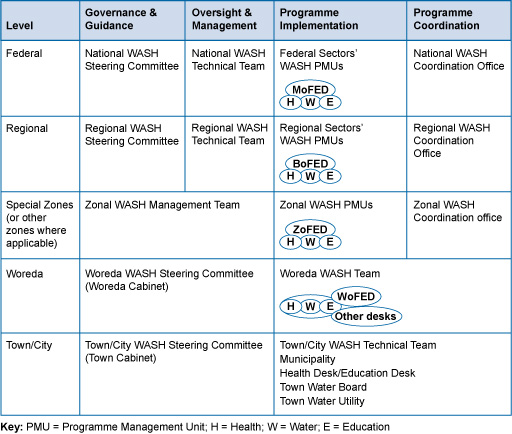Use 'Print preview' to check the number of pages and printer settings.
Print functionality varies between browsers.
Printable page generated Saturday, 20 April 2024, 2:13 PM
Study Session 7 Organisational Structure of the OWNP
Introduction
In the previous study session you learned about the four components of OWNP, namely: rural and pastoral WASH, urban WASH, institutional WASH and programme management and capacity building. You also learned that, for each of these components, the scope of OWNP includes water supply, hygiene and sanitation service provision.
In this study session you will learn about the governance and guidance of WASH sector organisations from federal to woreda level including their structure, and the roles and responsibilities of the different actors. This will help you understand how water supply, sanitation and hygiene activities are implemented, organised and coordinated at different levels.
Learning Outcomes for Study Session 7
When you have studied this session, you should be able to:
7.1 Define and use correctly all of the key words printed in bold. (SAQ 7.1)
7.2 Describe the organisational structure of the OWNP. (SAQs 7.1 and 7.2)
7.3 Explain the overall leadership hierarchy of the OWNP. (SAQs 7.2 and 7.3)
7.4 Describe the roles and responsibilities of the WASH sector ministries in relation to the OWNP. (SAQ 7.4)
7.5 Differentiate between the role and responsibility of the Woreda WASH Steering Committee and the Woreda WASH Team. (SAQ 7.5)
7.1 Introduction to the OWNP’s organisational structure
A programme of the size and scale of the OWNP needs an organised structure to ensure that activities are properly planned and implemented at all levels. An organisational structure describes relationships and defines how job tasks are formally subdivided, grouped and coordinated.
The general organisational structure for the OWNP is shown in Figure 7.1. From this diagram, you can see there are committees, teams and other groups who have responsibility for different aspects of the programme at all levels of administration from federal through regional and zonal to woredas, and towns and cities.
There are both horizontal and vertical organisational relationships between these groups. Vertical organisational relationships refer to the flow of information and decisions from the higher governmental organisations to the lower levels. An example of information in a vertical relationship could be a letter of invitation for refresher training of Health Extension Workers that would pass from the Federal Ministry of Health to the Regional Health Bureau and then to the woreda Health Office.
Horizontal organisational relationships describe the links between groups at a similar level, for example between ministries, between regional bureaus, or between woreda offices. The small blobs in the diagram show the four WASH sectors which have a horizontal relationship between them at each level. An example here could be a request for professional support from a Regional Bureau of Health to the Bureau of Water in the same region to supervise the construction of public latrines.
What are the four WASH sector ministries who share overall responsibility for the OWNP?
You will recall from Study Session 3 that the four ministries are the Ministry of Water, Irrigation and Energy, the Ministry of Health, the Ministry of Education, and the Ministry of Finance and Economic Development.
The four main column headings in Figure 7.1 describe the four areas of responsibility within the OWNP. The following sections of this study session explain the organisational structure under each of these headings in more detail.
7.2 Governance and guidance
Governance refers to high-level decision making and the development of strategies that will be implemented by others. Governance is closely linked to guidance, which means advice or counselling, in this instance on the proper implementation of the OWNP. Broadly speaking, in the context of WASH, governance means the range of political, social, environmental, economic and administrative systems that are in place to regulate the development and management of water resources and provision of water services at different levels (UNDP, 2005).
Federal level
The OWNP governing body at Federal level is the National WASH Steering Committee (NWSC). The NWSC is at the top of the OWNP hierarchy. It is responsible for providing the overall guidance and general direction for WASH sector ministries and their respective regional bureaus and woreda offices. The Committee’s responsibilities are wide ranging and include the approval of funding from partners and appropriate allocation of those funds, review and endorsement of strategic plans, and oversight of monitoring and evaluation of the OWNP among others (WIF, 2011; POM, 2014). (Monitoring and evaluation, often abbreviated to M&E, is an essential part of any project or programme. It involves collecting data before, during and after implementation so that success can be measured. It will be discussed in more detail in Study Session 13.) As national leaders, the NWSC announced the launch of the OWNP in September 2013, which received widespread publicity. Figure 7.2 shows members of the NWSC at the launch event.
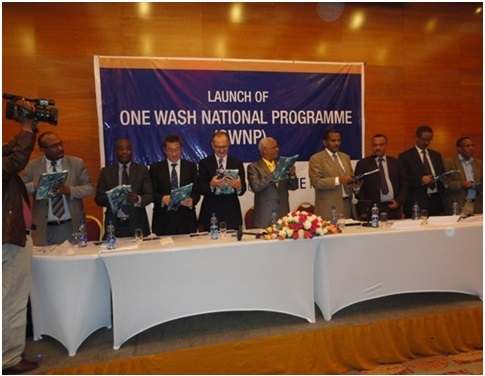
The NWSC includes representatives from the Federal WASH sector Ministries, as shown in Figure 7.3. The Committee is chaired by the Minister or State Minister of the Ministry of Water, Irrigation and Energy (MoWIE). The Chair of the National WASH Technical Team (NWTT), who is also Director of the Water Supply and Sanitation Directorate from the same Ministry, acts as Secretary. The other members are from the state ministries of Finance and Economic Development (MoFED), Health (MoH), and Education (MoE), and the Director General of the Water Resources Development Fund (WRDF). (You will learn about the WRDF in Study Session 9.) There may also be invited members representing the OWNP development partners and other stakeholders.
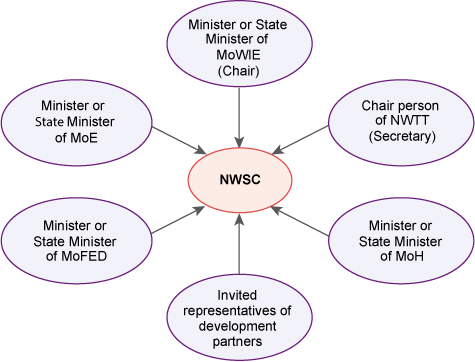
Regional level
The Regional WASH Steering Committee (RWSC) is responsible for WASH governance at regional level on behalf of the Regional State Council. Its responsibilities reflect those of the NWSC and include the preparation of consolidated regional WASH plans, budgets and reports, and M&E (POM, 2014).
RWSCs are composed of heads of the regional bureaus of the four WASH ministries. Depending on the regional context, they may add other sectors such as Women, Children and Youth Affairs, and Federal Affairs. The Chair of the RWSC is the Head of the Regional Water Bureau and the Secretary is the senior person with responsibility for water supply (the core process owner) from that bureau. The RWSC is accountable to, and receives guidance and information from, the NWSC. They cascade this guidance to regional WASH sector bureaus and Woreda WASH Steering Committees. RWSCs meet every quarter (i.e. four times a year) and report to the Regional State Council.
Woreda level
At woreda level, the Woreda WASH Steering Committee (WWSC) is responsible for governance of the OWNP. It is composed of members of the woreda cabinet from the offices of Water, Finance, Health, and Education. Other woreda offices such as Agriculture, and Women, Children and Youth Affairs may also be included. For example, the agriculture office may be represented on the team if there are local issues about a water source being used for both drinking water and irrigation.
Look again at Figure 7.1. You can see that the WWSC covers both governance and management. Its role is to provide guidance for the whole water supply, sanitation and hygiene programme; they are also responsible for planning, implementation and budget management in their woredas (POM, 2014).
Now compare it with Figure 7.4 which shows a sub-section from the larger diagram. This indicates how governance and guidance cascades down from national to lower levels, illustrating a vertical organisational relationship. Note that the town or city WASH Steering Committees are at an equivalent level to WWSCs and not one above the other. It also shows the horizontal relationship between steering committees and technical teams at national and regional level. The technical teams are responsible for managing the Programme, which is the subject of the next section.
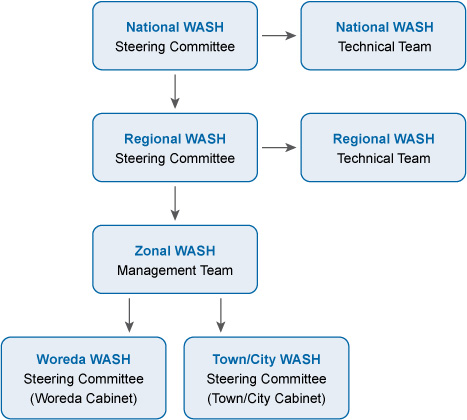
7.3 Oversight and management
For the OWNP, overall guidance of the programme is given by the steering committees, however they are not responsible for its management. Management can be described as the art of knowing what to do and then seeing that it is done in the best and most cost-effective way. In the OWNP context, management means knowing how the programme should be implemented and overseeing that implementation to make sure it is being done effectively and efficiently. There is, therefore, a close relationship between management and implementation. As you can see from Figure 7.1, implementation is the responsibility of the Programme Management Units (PMUs) and WASH teams. Implementation is described in Section 7.4.
Federal level
Management and oversight of implementing the OWNP at federal level is through the National WASH Technical Team (NWTT). They focus on managerial oversight of technical activities and are responsible for overseeing the plans that are executed by the WASH sector ministries. In their role they review and give advice on WASH proposals before they are sent to the NWSC for approval. They are also responsible for negotiating with regions about targets and the allocation of resources (POM, 2014).
The NWTT is accountable to the NWSC for performance against budget, plan and expected results in each of the WASH sector ministries. If there is an issue that requires a decision, the NWTT have to submit it to the NWSC. For example, there may be issues raised by a PMU about selecting the location of a new water supply scheme or choosing options for design and construction. The proposal and questions would be sent to the NWTT for technical advice. If the NWTT approves the scheme it then goes to the NWSC for endorsement, however if there is any disagreement, the final decision lies with the NWSC.
The team is composed of directors from relevant directorates in the four WASH ministries, the National WASH Coordinator and invited representatives of donors and Civil Society Organisations (CSOs). (These stakeholders are described in Study Session 9.) The assigned representative from the Ministry of Water, Irrigation and Energy is chair and the National WASH Coordinator serves as secretary.
Regional level
The Regional WASH Technical Team (RWTT) is responsible for managerial oversight of technical activities at regional level and has a similar membership profile to the national team. It comprisesdirectors or process owners assigned by the four WASH bureaus, the Regional WASH Coordinator and representatives of donors and WASH CSOs in the region. The representative from the Water Bureau is chair and the Regional WASH Coordinator is secretary (POM, 2014).
The RWTT provides direct oversight and direction for planning and implementing regional programme activities. They review plans, budgets and reports from the WASH sector bureaus and are accountable to the RWSC. They have responsibility for negotiating about targets and resources both upwards with NWTT at national level, and downwards with woredas and towns.
7.4 Implementation
You can see from Figure 7.1 that the third section of the OWNP structure is made up of the organisations responsible for implementation of the Programme who will undertake the planned activities. The day-to-day programme implementers are either institutions or teams of professionals who belong to the PMUs or WASH teams. (Note that PMUs are also sometimes referred to as WASH Management Units (WMUs) or WASH Programme Management Units (WPMUs)).
The various implementing institutions and teams each have their own roles and responsibilities at different levels. OWNP implementation activities are divided up along the lines of the separate WASH sector ministries.
Look at Figure 7.1. How does the organisational structure for implementation differ from that for governance and management?
Governance and management both have a single committee or team at all levels with representatives from each of the WASH ministries. For implementation, the four ministries have separate units with responsibility for their own activities.
7.4.1 Implementation in the main WASH ministries
The OWNP supports the implementation plan of all four WASH ministries. They each have different roles and responsibilities and function in different ways but they all prepare and submit their OWNP plans and report to the NWTT through the National WASH Coordination Office.
Water, Irrigation and Energy
The Ministry of Water, Irrigation and Energy (MoWIE) is responsible for the provision of safe drinking water to all the peoples of Ethiopia as mandated in the Water Resources Management Policy, which you read about in Study Session 2.
At federal level, MoWIE is responsible for water policy, coordination and monitoring. Implementation is decentralised to regional, woreda and, in some cases, community level. In general, design and contracting of piped water supply schemes are managed at regional water bureau level, before handing over maintenance responsibility to woredas or towns. Implementation of schemes such as hand-dug wells or springs is managed by the woreda Water Offices, or by communities.
Health
The Ministry of Health (MoH) is responsible for the sanitation and hygiene condition of all the people of Ethiopia as mandated in the various health policy documents. It is also responsible for WASH facilities of health institutions, including hospitals, clinics, health centres and health posts.
In Study Session 2 you read about the Health Sector Development Plan (HSDP) prepared by the MoH. The sanitation and hygiene element of the OWNP was based on the HSDP. It is implemented by regional health bureaus, which aims to scale-up delivery of primary care services through the Health Extension Programme and health clinics at district level (see also Study Session 6). Health Extension Workers (HEWs) are trained and deployed to health posts at kebele level in both rural and urban areas. HEWs work with communities and households, and in rural areas with members of the Health Development Army (HDA) to promote behavioural change, including using improved sanitation facilities, hygiene promotion and the eradication of open defecation.
Education
You already know about the importance of WASH in schools and how WASH facilities can affect school attendance and educational achievement. The Ministry of Education (MoE) has responsibility for the water supply, sanitation and hygiene conditions of all school communities. The MoE has prepared an Education Sector Development Plan (ESDP) to achieve the education MDGs by 2015. The strategies and activities of the ESDP include providing safe drinking water, renovating existing latrines and handwashing facilities, constructing new facilities and integrating hygiene education into the curriculum (MoE, 2010).The school sanitation and hygiene aspect of the OWNP is based on this plan and supports its implementation to achieve the target.
Finance and Economic Development
The Ministry of Finance and Economic Development (MoFED) determines and allocates budgets to all public institutions. It is responsible for implementing efficient ways of utilising WASH resources in both federal and regional governments. It has an important role in allocating and channeling resources and monitoring fund utilisation.
7.4.2 Programme Management Units and WASH teams
Programme Management Units (PMUs) are responsible for implementing OWNP plans and activities at federal and regional level, and zonally where appropriate. They have been established within an appropriate department of the three main implementing ministries. (There is no need for a PMU at MoFED because they do not undertake active WASH projects.) Their staff may be permanent employees, contract staff or consultants. The size and composition of each of the units will vary from ministry to ministry, depending on the magnitude and nature of the particular ministry’s activities related to WASH.
Federal level
At federal level, the PMUs in each ministry will ensure their respective regional PMUs, woreda and town sector offices have the directions, information, systems, skills and resources necessary to carry out their WASH mandate and achieve expected programme results. For example, the PMU would provide training for staff, review plans and designs, support M&E and so on.
Regional level
At regional level there is a similar structure. Each of the three bureaus (water, health, and education) have PMUs within an appropriate department. The size, structure and composition of each of the units will vary from bureau to bureau depending on the nature of the particular bureau’s input to the OWNP. A Unit Head will be appointed whose duties will include serving as the focal person for their bureau in the Regional WASH Coordination Office (see Section 7.5).
The regional PMU role and responsibilities are similar to the national level but at the next step down in the hierarchy. They ensure that the WASH teams have what they need to carry out their WASH activities. They tend to be responsible for larger projects, such as the construction of water supply schemes.
Woreda/Town WASH Team
Woreda WASH Teams or Town WASH Teams are responsible for implementing planned activities under the direct supervision of their woreda or town WASH Steering Committee. Membership includes the heads or representatives of the water, health, education and finance offices, and other permanent or contract staff with a variety of roles. These include coordinators, accountants/clerks, environmental health workers, development agents, WASH consultants, community facilitators, and contractors and suppliers.
The Woreda WASH Team (WWT) coordinates the input of the various sector offices, supports the daily management of the activities and is accountable for achieving expected results (POM, 2014). They are responsible for such activities as the construction of small-scale water schemes for communities, schools and health facilities, giving training on CLTSH (community-led total sanitation and hygiene) and other relevant topics for communities, HEWs, the HDA and others.
Community WASH committee
In rural areas, the community WASH Committee or WASHCO plays an important role in OWNP implementation by managing the operation and maintenance of specific water schemes. WASHCOs are established for one community in order to manage one specific WASH facility. They are accountable to the WWT. In one kebele there may be many WASHCOs depending on the number of WASH facilities. They have between five and six members, at least 50% of whom must be women. Case Study 7.1 describes one WASHCO in Amhara region.
Case Study 7.1 WASHCO at Alem Sefer
Alem Sefer village is near Meksignit, a rural kebele in Fogera district, Amhara Region. The village has a new water point that has been in use since December 2014. It provides safe water close to a community of 270 people.
Figure 7.5 shows the WASHCO of three women and two men who have been elected from the community to manage their water point.
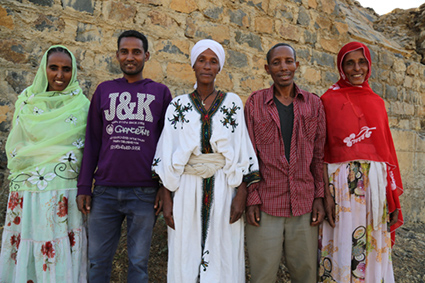
This community WASHCO is led by women. They have been chosen to lead because they understand that collecting water is predominately women’s responsibility: ‘It is us who are well aware of the challenges the lack of access to safe water brings to us and to our family,’ says Nurit Kalilu, the treasurer.
Hawa Wadajine, on the right in the photo, is the chairperson of this committee. She carries the overall responsibility of managing the water point. Nurit Kalilu, on the left, oversees the income which is generated from the collection of the monthly water tariff. This is 5 Birr/household, which is expected to bring in about 160 euros a year. The community has also deposited 60 euro as an up-front cash contribution to a bank account in the local micro-finance institution. This can later be used for the operation and maintenance of the water point.
7.5 Programme coordination
You will remember from Study Session 4 that one of the guiding principles of the OWNP is integration. To integrate water supply, hygiene and sanitation services there must be an effective organisational structure for coordination between WASH sector ministries. Programme coordination is the final part of the organisational structure shown in Figure 7.1, which shows how this is arranged at different levels.
7.5.1 National WASH Coordination Office
The National WASH Coordination Office (NWCO) is based in one of the federal WASH sector ministries by the decision of the NWSC; currently it is located in the MoWIE. It consists of a Coordinator (team leader), representatives from each of the partner ministries and professional staff contracted to implement daily activities.
The NWCO provides the NWTT with the information that they need in order to fulfil their role; they also ensure liaison between the three PMUs. They support the establishment and proper functioning of Regional WASH Coordination Offices, follow the functionality of the OWNP as per the signed MoU, WIF and POM and liaise between WASH sector ministries and their development partners.
7.5.2 Regional and zonal WASH coordination offices
Similar coordination offices also exist at regional and zonal levels. These offices are based in one of the WASH sector bureaus, usually the Bureau of Water, and have a similar pattern of membership to the national offices: namely a Coordinator (team leader), representatives from the three partner bureaus and contracted professional staff.
As before, the size and composition of the regional and zonal coordinating offices varies. Their roles are similar to the national office but operating at regional or zonal level respectively. They support the WWTs, develop capacity building programmes in their region/zone, ensure woredas have consolidated WASH plans and maintain WASH management systems and records.
Summary of Study Session 7
In Study Session 7, you have learned that:
- Major programmes of activities like the OWNP need a good organisational structure that clearly defines roles and responsibilities and describes relationships between groups at all levels of the organisation.
- Relationships within organisations may be vertical (between higher and lower levels) or horizontal (between groups at the same level).
- The OWNP structure is organised into four main types of activity: governance and guidance, oversight and management, implementation and coordination. There are separate committees or teams for each of these activities at federal, regional, zonal, and woreda or town/city levels.
- Governance and overall strategic leadership of the OWNP is the responsibility of the National WASH Steering Committee (NWSC).
- OWNP implementation is managed at national and regional levels by WASH technical teams. Implementation itself is the responsibility of Programme Management Units (PMUs) in the three main WASH ministries/bureaus. Each of these has their own areas of responsibility and undertake activities towards achieving WASH improvement targets.
- At community level, WASH Committees ensure communities take responsibility for the operation and maintenance of specific water schemes. Half of WASHCO members must be women.
- OWNP activities and communications are coordinated by coordination offices at national, regional and zonal levels. They exchange information between groups and liaise between different parts of the organisational structure.
Self-Assessment Questions (SAQs) for Study Session 7
Now that you have completed this study session, you can assess how well you have achieved its Learning Outcomes by answering these questions.
SAQ 7.1 (tests Learning Outcome 7.1)
- a.Management, governance and guidance are similar concepts, but have important differences. Use one of these three terms to complete the following sentences.
High-level decision making is an aspect of ………………
Coordination of resources within an organisation is the responsibility of ………………
Giving advice is part of the role of ………………
The ‘art of knowing what to do’ is a description of ………………
The development of strategies that will be organised by others is ………………
Organising people who implement projects is the responsibility of ………………
Answer
- a.High-level decision making is an aspect of governance.
Coordination of resources within an organisation is the responsibility of management.
Giving advice is part of the role of guidance.
The ‘art of knowing what to do’ is a description of management.
The development of strategies that will be organised by others is governance.
Organising people who implement projects is the responsibility of management.
- b.Insert the words ‘vertical’, ‘structure’ and ‘horizontal’ in this statement:
An organisational ……………… describes how relationships, tasks and communication flows are coordinated within and between organisations. If these links are between a higher level and a lower level, these are ……………… relationships; if they are between groups at a similar level they are ……………… relationships.
Answer
- b.An organisational structure describes how relationships, tasks and communication flows are coordinated within and between organisations. If these links are between a higher level and a lower level, these are vertical relationships; if they are between groups at a similar level they are horizontal relationships.
- c.Write out in full what the following abbreviations stand for in the table below:
| Abbreviation | Hint | Full term |
|---|---|---|
| NWSC | At the top of the OWNP hierarchy | |
| RWSC | Responsible for WASH governance at regional level | |
| NWTT | Focuses on managerial oversight of technical activities at the regional level. | |
| RWTT | Responsible for managerial oversight of technical activities at regional level. | |
| PMUs | Responsible for implementation at federal, regional and zonal levels. | |
| WWTs | Responsible for implementation at the woreda or town level. | |
| NWCO | Based in one of the federal WASH sector ministries. | |
| WWSC | Responsible for governance of the OWNP at the woreda level. | |
| WASHCO | Manages the operation and maintenance of specific water schemes. |
Answer
- c.The answer is below:
| Abbreviation | Hint | Full term |
|---|---|---|
| NWSC | At the top of the OWNP hierarchy | National WASH Steering Committee |
| RWSC | Responsible for WASH governance at regional level | Regional WASH Steering Committee |
| NWTT | Focuses on managerial oversight of technical activities at the regional level. | National WASH Technical Team |
| RWTT | Responsible for managerial oversight of technical activities at regional level. | Regional WASH Technical Team |
| PMUs | Responsible for implementation at federal, regional and zonal levels. | Programme Management Units |
| WWTs | Responsible for implementation at the woreda or town level. | Woreda WASH Teams |
| NWCO | Based in one of the federal WASH sector ministries. | National WASH Coordination Office |
| WWSC | Responsible for governance of the OWNP at the woreda level. | Woreda WASH Steering Committee |
| WASHCO | Manages the operation and maintenance of specific water schemes. | community WASH Committee |
SAQ 7.2 (tests Learning Outcomes 7.1 and 7.2)
Look at Figure 7.6 and fill in the missing labels using the following abbreviations: WWT, NWCO, RWTT, NWSC.
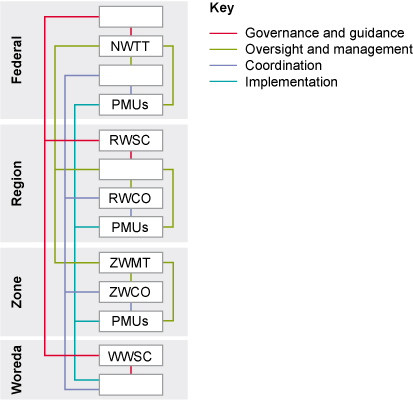
Answer
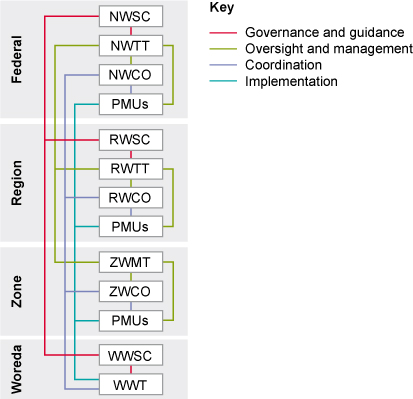
SAQ 7.3 (tests Learning Outcomes 7.2 and 7.3)
Which of the following sequences represents the correct leadership hierarchy of the OWNP?
- a.NWSC → RWSC → NWTT → WSC
- b.NWTT → NWSC → NWCO → RWCO
- c.RWSC → NWSC → RWTT → NWTT
- d.NWSC → RWSC → WWSC → WWT
Answer
Option (d) is the correct sequence. It shows the vertical relationship of steering committees at different levels from national to regional to woreda, and the horizontal relationship at woreda level from Woreda Steering Committee to the Woreda WASH Team.
SAQ 7.4 (tests Learning Outcome 7.4)
Explain the main role and responsibilities of each of the four WASH sector ministries in relation to the OWNP.
Answer
- The Ministry of Water, Irrigation and Energy (MoWIE) is responsible for the provision of safe water.
- The Ministry of Health (MoH) is responsible for the provision of sanitation and hygiene for the community and provision of WASH facilities for health institutions.
- The Ministry of Education (MoE) is responsible for the provision of WASH facilities for schools.
- The Ministry of Finance and Economic Development (MoFED) is responsible for the financial management of the OWNP.
SAQ 7.5 (tests Learning Outcome 7.5)
At woreda level, which aspects of the OWNP are the responsibility of the Steering Committee and which of the Woreda WASH Team?
Answer
At every level, steering committees have responsibility for governance, however the Woreda Steering Committee also has responsibility for management at the woreda level. The Woreda WASH Team is responsible for implementation and coordination. The Woreda WASH Team will also work with community WASH Committees (WASHCOs) on specific projects.
